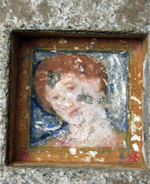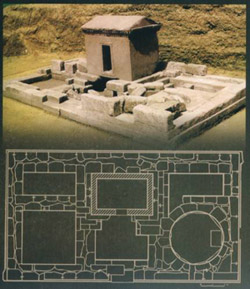Tomb of Ostrusha
Tomb of Ostrusha
It is located 10 km north of Kazanlak
The temple dates from the middle of the 4th century BC. There are six rooms.
A horse was ritually sacrificed in the square southwest chamber.
The ceiling of the tomb impresses with its coffered structure and the only preserved image of an exquisite female head.
The central chamber is carved out of a single block of granite weighing about 60 tons.
A horse was ritually sacrificed in the square southwest chamber.
The ceiling of the tomb impresses with its coffered structure and the only preserved image of an exquisite female head.
The central chamber is carved out of a single block of granite weighing about 60 tons.


The tomb-cult complex was discovered on March 13, 1993 near the town of Shipka and is a unique archaeological discovery. The complex has six rooms, and pithos, amphorae and architectural details are placed in front of them in rows.
From the south, one enters a central, “distributive” room with three entrances to the chambers to the side and to the north.
On the right, the room has a circular plan and a domed cover. The rest are built of processed granite blocks with a two-slope coating.
The southwest chamber is square and not looted. A horse sacrifice was performed in it and the metal objects for the ritual were found on site. Appliqués from the horse ammunition were also found in this chamber – a boss in the form of a stylized double ax and with a three-dimensional griffin’s head, and six silver studs. All are richly decorated with animal and plant ornaments.
From the south, one enters a central, “distributive” room with three entrances to the chambers to the side and to the north.
On the right, the room has a circular plan and a domed cover. The rest are built of processed granite blocks with a two-slope coating.
The southwest chamber is square and not looted. A horse sacrifice was performed in it and the metal objects for the ritual were found on site. Appliqués from the horse ammunition were also found in this chamber – a boss in the form of a stylized double ax and with a three-dimensional griffin’s head, and six silver studs. All are richly decorated with animal and plant ornaments.
Highly deformed silver phials and a jug were also found. A monolithic sarcophagus-like burial chamber is placed on a tall stelobat with three steps, the walls of which are very well worked on the outside and inside. It is held to him by a thick cast of lead. The chamber itself is carved from one monolithic block of granite, which in its finished state weighs about 40 tons and is from a quarry on the northern slopes of Sredna Gora. Against the north wall is a modeled box, which in front has vertical bands shaped like legs and a plastic horizontal band. There is a step leading to the bed, which ends in lion’s paws.
The burial chamber is covered with a 20-ton pitched roof made of granite monolithic block. Its two pediments and cornice are covered with a fine white plaster resembling marble.
The ceiling of the chamber is interestingly shaped: in the middle there is a large circle – the solar disk, which is outlined by two squares inscribed in each other, and around them in all directions are located 38 square cassettes.
The ceiling is covered with frescoes, with some of the details highlighted in gold.
From the preserved painting, it is judged that the cassettes once contained portraits, ornaments, mythological scenes and scenes from everyday life.
The best preserved is the miniature representation of a female head with short brown hair, gold earrings and a gold necklace. She is strikingly beautiful and spiritual. Somewhere around the 4th century AD. the tomb-cult complex was looted by the early Christians, and the frescoes on the ceiling were destroyed, as they were pagan for them.
The ceiling of the chamber is interestingly shaped: in the middle there is a large circle – the solar disk, which is outlined by two squares inscribed in each other, and around them in all directions are located 38 square cassettes.
The ceiling is covered with frescoes, with some of the details highlighted in gold.
From the preserved painting, it is judged that the cassettes once contained portraits, ornaments, mythological scenes and scenes from everyday life.
The best preserved is the miniature representation of a female head with short brown hair, gold earrings and a gold necklace. She is strikingly beautiful and spiritual. Somewhere around the 4th century AD. the tomb-cult complex was looted by the early Christians, and the frescoes on the ceiling were destroyed, as they were pagan for them.



